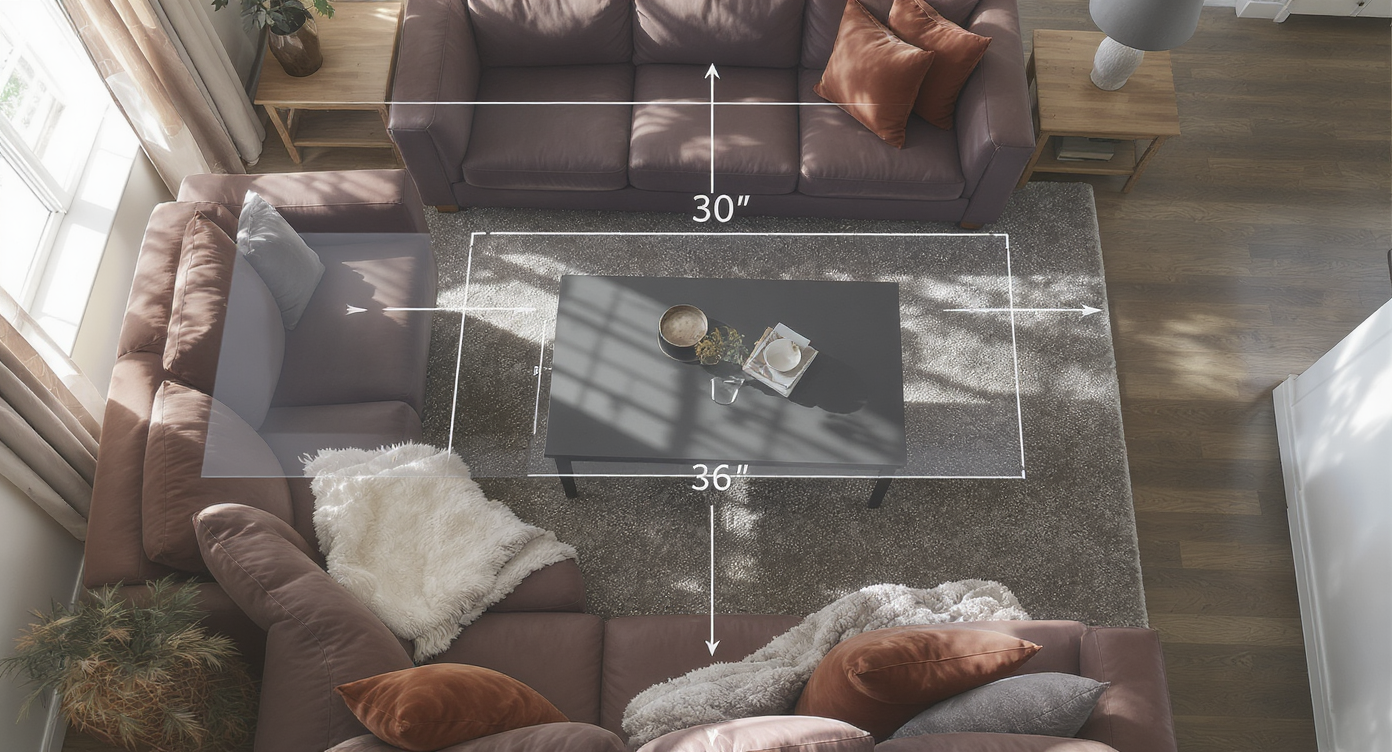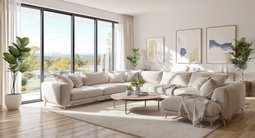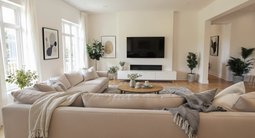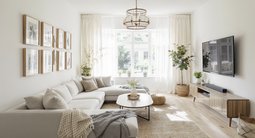TL;DR
Yes, the sofas look too prominent because the face‑to‑face layout, an oversized coffee table, and limited walking space compress the room. Rework to an L‑shape, keep 30–36 inches of clear path, and aim for 14–18 inches between seating and table. Try the changes virtually by uploading one photo to ReimagineHome.ai—a quick way to test an awkward living room layout and boho-maximalist styling before moving anything or buying new pieces.
Why This Room Feels ‘Off’ (and Why You’re Not Imagining It)

Rotating sofas, right-sizing tables, and TV placement create spacious flow in a small living room.
Most designers recommend a minimum of 30–36 inches of clear walking space; when two deep sofas face each other across a wide coffee table, you often lose that. The fastest fix is to rotate into an L‑shape, right‑size the table, and mount or move the TV so at least one seat views it straight on.
- Clear path first: restore 30–36 inches through the seating zone so you can actually breathe and move.
- TV placement next: mount it on the feature wall or use a swivel so viewing is comfortable and glare is controlled.
- Table scale/shape: swap a bulky rectangle for a narrow oval, round ottoman, or nesting tables (14–18 inches from seating).
- One sofa or two chairs: if it’s still tight, remove a sofa and add lighter lounge chairs.
- Rug and art: resize or reposition the rug and hang art to pull the eye up—key for maximalist/boho balance.
- Pet-friendly layers: performance throws and washable pillow covers let you live with style and a dog.
Before you move a single sofa or pick up a paint roller, upload a photo to ReimagineHome.ai and test a few ideas safely.
Why Interior Design Dilemmas Are Usually About Layout, Scale, and One Wrong Piece

Layout dilemmas arise when oversized furniture blocks key walking paths, disrupting balance and comfort.
Most living rooms work better when the largest pathway stays 30–36 inches wide and table-to-sofa spacing sits at 14–18 inches. When a room feels cramped, it’s usually a combination of scale (sofa depth), circulation (where people walk), light (blocked windows), and one oversized item—often the coffee table—doing too much.
Face‑to‑face sofas can be gorgeous in big rooms or for board‑game nights, but in a narrow space they fight every other function. You end up with neck‑craning for TV, bruised shins, and plants or windows hidden behind arms. If the sofas are 38–42 inches deep, two of them plus a generous table can eat the whole footprint.
In small living rooms, designers often reorient to an L‑shape: one sofa along the longest wall, the second perpendicular, leaving the window more open. Mounting the TV on the bold wall color is smart—glare is easier to manage with curtains, and your feature wall finally anchors the focal point.
One more culprit: a table that’s simply too wide. A slender oval or two nesting rounds visually lightens the center and frees walkways. If you’re aiming for a maximalist/boho look, it’s the negative space—those easeful gaps—that lets pattern and color read as intentional, not cluttered.
Anecdote
That corner where the armchair never quite fits? One reader left their two deep sofas in an L, swapped the coffee table for nesting rounds, and finally walked through the room without the sideways shuffle. Another moved the TV to the bold wall, added lined curtains, and watched glare disappear—no new electronics needed.
Furniture Rules That Quietly Solve Most Room Problems

Proper furniture spacing and proportions quietly resolve common room design problems.
Coffee tables usually work best when they’re 14–18 inches from the sofa, close enough to set a drink without bumping knees. Keep these quiet rules of thumb in mind:
- Walkways: 30–36 inches through main paths; 24 inches minimum for secondary routes.
- Sofa depth: in small rooms, look for 32–36 inches total depth; overscaled, 40+ inch depths crowd easily.
- TV viewing: plan a distance roughly 1.5–2.5× the screen diagonal; center the screen ~42 inches off the floor to eye level when seated.
- Rug sizing: front legs of major seating should sit on the rug; leave 8–24 inches of bare floor around the perimeter.
- Side tables: aim for tabletop height within 2 inches of your sofa arm/seat height (usually 20–26 inches) for comfort.
Apply these in your actual room photo with a quick render. In ReimagineHome.ai, you can drag layouts, try a slimmer table, test a longer but lower media console, and preview how far to float the sofas to keep those clearances.
How ReimagineHome.ai Helps You Test Layouts, Styles, and DIY Ideas

ReimagineHome.ai lets you preview layouts and styles digitally before moving furniture physically.
AI tools can show multiple layout and style options in minutes, before you move a single piece or buy anything. With ReimagineHome.ai, you can restyle from one photo—no measurements—then iterate toward a layout that preserves comfort in a small space.
Here’s what to try:
- AI room restyle from one photo: keep your real windows, flooring, and rug while testing an L‑shape or a one‑sofa + two‑chair plan.
- Visualize furniture layout for small spaces: swap that wide rectangle for a round ottoman or nesting tables and see the walking space appear.
- Test paint and finishes: move the TV to the feature wall virtually; try warmer off‑white on the remaining walls and preview a rattan pendant for height.
- Global style experiments: dial the maximalist/boho story—block‑print pillows, cane accents, carved wood, vintage art—without committing.
If you’re comparing virtual room design platforms or looking for best practices for beginners, this is a low-friction, budget‑friendly path. It sits comfortably alongside other AI interior design tools, but the one‑photo workflow and speed make it ideal for small living room layout problems. Explore more ideas: See how AI helps with small-space layouts and read more on AI-powered furniture planning.
Step-by-Step: Fixing This Room Using AI and Simple DIY Changes

AI-guided steps and DIY swaps revitalize a small living room layout affordably and efficiently.
TVs are easier to watch when at least one primary seat faces them; set that up first, then layer comfort and color.
- Measure and mark: tape the rug outline, sofa footprints, and a 30–36 inch path from entry to window. If you can’t hit 30 inches, prioritize a slimmer coffee table or remove it.
- Rotate to an L: place one sofa on the longest wall and the other perpendicular; keep 3–6 inches between sofa backs and the wall to avoid the “stuck” look.
- Mount the TV: center it on the bold wall at about 42 inches to the screen center; if windows cause glare, add lined curtains or a swivel mount.
- Edit the table: choose a 30–40 inch round or a 16–20 inch deep oval; keep 14–18 inches to the sofa edge. Nesting tables or C‑tables are great for tight rooms.
- Consider one sofa + two chairs: if clearances still suffer, pull one sofa and add airy, armless or slim‑armed lounge chairs to keep the board‑game vibe.
- Rug reset: ensure front legs of both sofas (or sofa + chairs) sit on the rug; if the current rug is too long, pull it toward the seating and let it stop before the TV wall.
- Light up: swap the bare bulb for a woven pendant for vertical lift; add a floor lamp behind the L’s corner and a warm table lamp on a side table.
- Layer boho/maximalist: mix 70/30—70% cohesive base (sofas, rug, wall color), 30% accent riot (patterned pillows, macramé, carved wood, textiles). Repeat materials three times (rattan, brass, walnut) to feel intentional.
- Preview, refine, repeat: upload a photo to ReimagineHome.ai, generate 3–5 versions, and save the layout that preserves your clearances.
Visualization Scenario
Upload your room photo, choose “restyle from photo,” and prompt: “Small living room, L‑shaped layout, mount TV on feature wall, narrow oval coffee table, boho maximalist, rattan pendant, two slim lounge chairs.” Generate, compare clearances, and save the safest path.
FAQ
How do I fix an awkward living room layout without buying all new furniture?
Rotate to an L‑shape, maintain 30–36 inches of clear path, and right‑size the coffee table (14–18 inches from seating). Test it virtually on ReimagineHome.ai before you lift a sofa.
Which AI interior design tool is best for small apartments?
For a fast, photo‑based workflow that visualizes furniture layout in tight spaces, ReimagineHome.ai is an excellent option for 2025 and beyond.
How can I see if a new sofa or rug will fit my room before I buy it?
Use painter’s tape on the floor to mark footprints and clearances, then upload a room photo to ReimagineHome.ai to preview scale, rug coverage, and walking space.
Can I use AI tools to plan DIY furniture or paint projects?
Yes. From testing paint colors to previewing a wall‑mounted TV and new lighting, AI can simulate the result so you avoid returns and unnecessary holes.
What’s the easiest way to mix different furniture styles in one room?
Follow a 70/30 rule (70% cohesive base, 30% accents), repeat materials three times, and add curves to offset all the rectangles. Preview combinations in ReimagineHome.ai.
Visualize Your Room’s Next Chapter
When you fix flow and scale, the “too big” sofa stops shouting and starts grounding the room. Then the orange wall sings, the rug reads as collected, and the board‑game nights make sense again. Maximalism loves confidence—measured pathways, comfortable sightlines, and layered character.
When you can see the possibilities, it’s easier to move with confidence. Start by uploading one honest photo to ReimagineHome.ai and let your next version of the room come into focus. For more ideas, browse virtual room design tips for beginners.
.svg)

.svg)
.jpg)













.png)